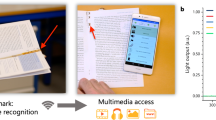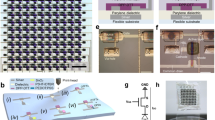Abstract
Solution-processed photodetectors could be of use in large-area light-sensing applications because they can be fabricated at low cost on plastic substrates and their absorption spectra can be tuned by chemical design. However, fabricating photodetectors with low dark currents and integrating them into high-resolution backplanes remains challenging. Here we show that solution-processed metal halide perovskite photodiodes on top of an amorphous indium gallium zinc oxide transistor backplane can be used to create a flexible image sensor that is ~100 μm thick and has a resolution of 508 pixels per inch. We have developed a pixel edge cover layer for the system that reduces electrode current leakage and thus dark current density. The low noise current in combination with high external quantum efficiency results in high photodetectivity at wavelengths from 550 nm to 770 nm. We show that our imager can be used for document scanning and biometric fingerprinting and that it can be wrapped around objects with radii as small as 0.6 cm.
This is a preview of subscription content, access via your institution
Access options
Access Nature and 54 other Nature Portfolio journals
Get Nature+, our best-value online-access subscription
$29.99 / 30 days
cancel any time
Subscribe to this journal
Receive 12 digital issues and online access to articles
$119.00 per year
only $9.92 per issue
Buy this article
- Purchase on Springer Link
- Instant access to full article PDF
Prices may be subject to local taxes which are calculated during checkout





Similar content being viewed by others
Data availability
The datasets analysed in this study are available from the corresponding authors upon reasonable request.
References
Cui, D. et al. Color-tuned perovskite films prepared for efficient solar cell applications. J. Phys. Chem. C 120, 42–47 (2016).
Chen, C.-W. et al. Optical properties of organometal halide perovskite thin films and general device structure design rules for perovskite single and tandem solar cells. J. Mater. Chem. A 3, 9152–9159 (2015).
Herz, L. M. Charge-carrier mobilities in metal halide perovskites: fundamental mechanisms and limits. ACS Energy Lett. 2, 1539–1548 (2017).
Stranks, S. D. et al. Electron-hole diffusion lengths exceeding 1 micrometer in an organometal trihalide perovskite absorber. Science 342, 341–344 (2013).
Burschka, J. et al. Sequential deposition as a route to high-performance perovskite-sensitized solar cells. Nature 499, 316–319 (2013).
Stranks, S. D. & Snaith, H. J. Metal-halide perovskites for photovoltaic and light-emitting devices. Nat. Nanotechnol. 10, 391–402 (2015).
Veldhuis, S. A. et al. Perovskite materials for ligh emitting diodes and lasers. Adv. Mater. 28, 6804–6834 (2016).
Dou, L. et al. Solution-processed hybrid perovskite photodetectors with high detectivity. Nat. Commun. 5, 5404 (2014).
Wang, H. & Kim, D. H. Perovskite-based photodetectors: materials and devices. Chem. Soc. Rev. 46, 5204 (2017).
Wang, Y. et al. CH3NH3PbI3/C60 heterojunction photodetectors with low dark current and high detectivity. Org. Electron. 42, 203–208 (2017).
Zeng, J. et al. Interfacial-tunneling-effect-enhanced CsPbBr3 photodetectors featuring high detectivity and stability. Adv. Funct. Mater. 29, 1904461 (2019).
Gu, L. et al. 3D arrays of 1,024-pixel image sensors based on lead halide perovskite nanowires. Adv. Mater. 28, 9713–9721 (2016).
Lee, W. et al. High-resolution spin-on-patterning of perovskite thin films for a multiplexed image sensor array. Adv. Mater. 29, 1702902 (2017).
Liu, Y. et al. Inkjet-printed photodetector arrays based on hybrid perovskite CH3NH3PbI3 microwires. ACS Appl. Mater. Interfaces 9, 11662–11668 (2017).
Deng, W. et al. All-sprayed-processable, large-area, and flexible perovskite/MXene-based photodetector arrays for photocommunication. Adv. Opt. Mater. 7, 1801521 (2019).
Xue, J. et al. Narrowband perovskite photodetectors based image array for potential application in artificial vision. Nano Lett. 18, 7628–7634 (2018).
Wu, W. et al. Flexible photodetector arrays based on patterned CH3NH3PbI3-xClx perovskite film for real-time photosensing and imaging. Adv. Mater. 31, 1805913 (2019).
Zhu, H. L. et al. Achieving high-quality Sn-Pb perovskite films on complementary metal-oxide-semiconductor-compatible metal/silicon substrates for efficient imaging array. ACS Nano 13, 11800–11808 (2019).
Wang, Y. et al. Spin-on-patterning of Sn-Pb perovskite photodiodes on IGZO transistor arrays for fast active-matrix near-infrared imaging. Adv. Mater. Technol. 5, 1900752 (2020).
Zou, T. et al. Flexible, active-matrix flat-panel image sensor for low dose X-ray detection enabled by integration of perovskite photodiode and oxide thin film transistor. In Proc. 2019 IEEE International Electron Devices Meeting (IEDM) 174–177 (IEEE, 2019).
Galagan, Y. et al. Roll-to-roll slot die coated perovskite for efficient flexible solar cells. Adv. Energy Mater. 8, 1801935 (2018).
Saliba, M. et al. Incorporation of rubidium cations into perovskite solar cells improves photovoltaic performance. Science 354, 206–209 (2016).
Saliba, M. et al. Cesium-containing triple cation perovskite solar cells: improved stability, reproducibility and high efficiency. Energy Environ. Sci. 9, 1989–1997 (2016).
Głowienka, D. et al. Effect of different bromine sources on the dual cation mixed halide perovskite solar cells. ACS Appl. Energy Mater. 3, 8285–8294 (2020).
Gil-Escrig, L. et al. Vacuum deposited triple cation mixed halide perovskite solar cells. Adv. Energy Mater. 8, 1703506 (2018).
Zhang, M. et al. High-efficiency rubidium-incorporated perovskite solar cells by gas quenching. ACS Energy Lett. 2, 438–444 (2017).
Mulato, M., Hong, C. M. & Wagner, S. Size and etching effects on the reverse current of a-Si:H p-i-n diodes. J. Electrochem. Soc. 150, G735 (2003).
Nill, N. B. Test Procedures for Verifying Image Quality Requirements for Personal Identity Verification (PIV) Single Finger Capture Devices. Mitre Technical Report MTR060170R5 (MITRE, 2006).
Nill, N. B., Lepley, M. A., Bas, C. F. Test Procedures for Verifying IAFIS Image Quality Requirements for Fingerprint Scanners and Printers. Mitre Technical Report MTR05B0016R9 v1.5 (MITRE, 2016).
Hu, H. et al. Nucleation and crystal growth control for scalable solution-processed organic-inorganic hybrid perovskite solar cells. J. Mater. Chem. A 8, 1578–1603 (2020).
van de Weijer, P. & Akkerman, H. B. Spotless hybrid thin-film encapsulation stack for organic light-emitting diodes on organic foils. Org. Electron. 66, 43–46 (2019).
Kronemeijer, A. J. et al. Dual-gate self-aligned IGZO TFTs monolithically integrated with high-temperature bottom moisture barrier for flexible AMOLED. SID Symp. Dig. Tech. Pap. 49, 1577–1580 (2018).
Chen, B. et al. Enhanced optical path and electron diffusion length enable high-efficiency perovskite tandems. Nat. Commun. 11, 1257 (2020).
Zhang, D., Liu, F., Zhao, Q., Lu, G. & Luo, N. Selecting a reference high resolution for fingerprint recognition using minutiae and pores. IEEE Trans. Instrum. Meas. 60, 863–871 (2011).
Tordera, D. et al. A high resolution thin film fingerprint sensor using a printed organic photodetector. Adv. Mater. Technol. 4, 1900651 (2019).
Li, F. et al. Integration of flexible AMOLED displays using oxide semiconductor TFT backplanes. SID Symp. Dig. Tech. Pap. 45, 431–434 (2014).
Zardetto, V. et al. Atomic layer deposition for perovskite solar cells: research status, opportunities and challenges. Sustain. Energy Fuels 1, 30–55 (2017).
Fang, Y., Armin, A. & Meredith, P. Accurate characterization of next-generation thin-film photodetectors. Nat. Photon. 13, 1–4 (2019).
Acknowledgements
We thank the process engineers of Holst Centre’s R&D TFT Pilot Line for the realization of the TFT backplanes, as well as the thin-film encapsulation on top of the PPD frontplane. We also acknowledge M. Fattori (Eindhoven University of Technology) for his help with the noise measurements. This work is partly financed through the Flexlines project within the Interreg V-programme Flanders–Netherlands, a cross-border cooperation programme with financial support from the European Regional Development Fund, and co-financed by the Province of Noord-Brabant, Netherlands.
Author information
Authors and Affiliations
Contributions
F.D.G., S.V. and R.A. developed the PPD frontplane. R.O., S.S. and C.H.F. fabricated discrete PPDs and PPD arrays. R.O., S.S. and A.J.J.M.v.B. performed electrical characterization of discrete PPDs. B.P., L.C.J.M.P., R.L.v.d.K., I.K. and H.B.A. characterized the PPD arrays. A.J.J.M.v.B. and G.H.G analysed the results and wrote the manuscript. R.A.J.J. and E.A.M. corrected the draft manuscript. All authors discussed and revised the final manuscript. A.J.J.M.v.B. supervised the project.
Corresponding authors
Ethics declarations
Competing interests
The authors declare no competing interests.
Additional information
Peer review information Nature Electronics thanks Zhiyong Fan, Hang Zhou and the other, anonymous, reviewer(s) for their contribution to the peer review of this work.
Publisher’s note Springer Nature remains neutral with regard to jurisdictional claims in published maps and institutional affiliations.
Supplementary information
Supplementary Information
Supplementary Figs. 1–10.
Rights and permissions
About this article
Cite this article
van Breemen, A.J.J.M., Ollearo, R., Shanmugam, S. et al. A thin and flexible scanner for fingerprints and documents based on metal halide perovskites. Nat Electron 4, 818–826 (2021). https://doi.org/10.1038/s41928-021-00662-1
Received:
Accepted:
Published:
Issue Date:
DOI: https://doi.org/10.1038/s41928-021-00662-1
This article is cited by
-
A multifunctional display based on photo-responsive perovskite light-emitting diodes
Nature Electronics (2024)
-
p-Si/n-CrSe2 Heterojunctions Designed as High-Frequency Capacitors and Photosensors
Journal of Electronic Materials (2024)
-
Low-dimensional wide-bandgap semiconductors for UV photodetectors
Nature Reviews Materials (2023)
-
High-performance broadband flexible photodetector based on Gd3Fe5O12-assisted double van der Waals heterojunctions
Microsystems & Nanoengineering (2023)
-
Flexible and broadband colloidal quantum dots photodiode array for pixel-level X-ray to near-infrared image fusion
Nature Communications (2023)



